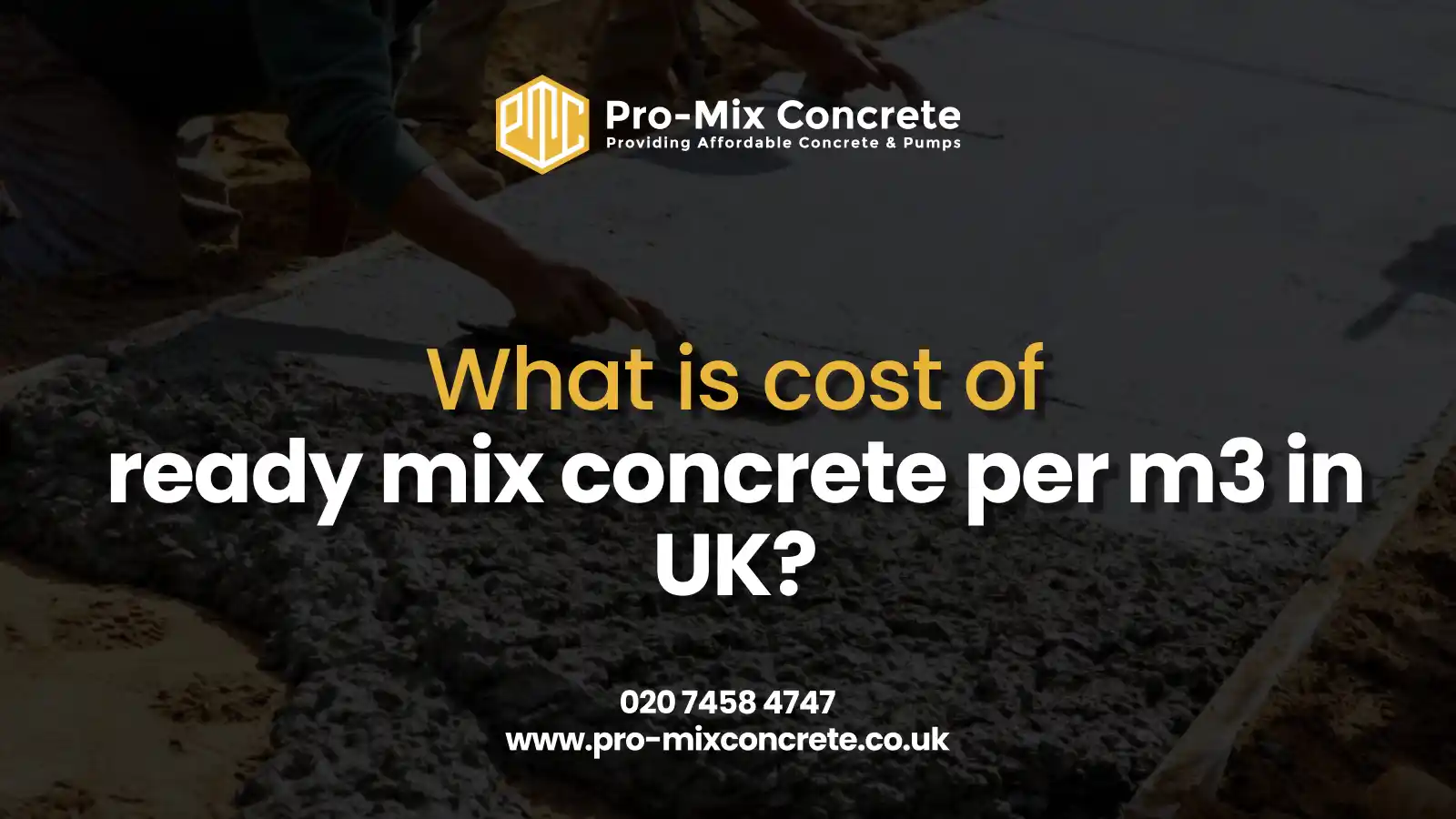Ready mix concrete costs vary significantly in the UK, depending on mix strength, delivery distance, and order volume. Standard C20 concrete and higher-strength C40 mixes have different pricing structures before delivery fees and surcharges are applied.
Concrete price per m3 varies significantly across the UK based on your location, project requirements, and supplier competition. Understanding these cost factors helps you budget accurately and avoid surprise charges that inflate your final bill.
Planning a driveway, patio, or foundation requires knowing exactly what you’ll pay for concrete. The advertised price rarely tells the complete story, with delivery fees, small load charges, and waiting time costs adding substantially to base rates.
Why Choose Ready Mix Concrete?
Ready mix concrete arrives pre mixed from a batching plant in rotating mixer trucks, eliminating on-site mixing labour and ensuring consistent quality. This factory-mixed concrete contains precisely measured cement, aggregates, water, and additives blended to exact specifications.
The UK has approximately 1200 ready-mixed concrete plants producing 23.5 million cubic metres of concrete annually. This extensive network means most construction sites can access fresh concrete within reasonable delivery distances.
Choosing ready-mix over site mixed concrete offers several advantages. The batching plant controls mix proportions with computerised accuracy. You avoid purchasing and storing materials. Professional delivery ensures fresh concrete arrives exactly when needed.
Pro-Tip:
Ready-mix concrete starts setting within 90 minutes of leaving the plant. Calculate your pour time carefully and have enough workers ready to place concrete immediately upon delivery. Delays cost money and compromise concrete quality.
If you’re unsure how much to order or how long your pour will take, Pro-Mix Concrete’s team can help you calculate volume and plan the timing, so you don’t waste a single batch.
5 Reasons Ready Mix Concrete Costs Vary Across the UK
Understanding why the concrete price per m3 differs helps you identify realistic quotes and spot overcharging. The UK lacks standardised national pricing for ready-mix concrete. Each supplier sets rates based on local market conditions, operating costs, and competition levels. A cubic metre in Birmingham might cost significantly less than in rural Cornwall for identical mix specifications.
Key pricing variations:
- Regional differences stem from aggregate availability and local wage rates
- Urban suppliers benefit from higher order volumes that spread fixed costs
- Remote locations face increased fuel expenses and longer delivery times
- Market competition creates the biggest price variations between suppliers
- Supplier size impacts pricing, with national chains often offering competitive rates
Areas with multiple suppliers see aggressive pricing as companies compete for projects. Regions with only one or two suppliers typically face higher rates due to limited alternatives.
7 Key Factors That Influence Ready-Mix Concrete Price Per m³
Multiple variables affect what you ultimately pay for ready-mix concrete. Understanding these factors helps you request accurate quotes and identify opportunities to reduce costs without compromising quality.
1. Mix Type And Strength Requirements
Concrete strength grades determine pricing, with higher strength mixes costing more due to increased cement content. Standard grades include C10 for light applications, C20 for domestic driveways and patios, C25 for foundations, C30 for structural work, C35 concrete and C40 for heavy-duty commercial applications.
Common mix types include:
- C10/C15 concrete for blinding and sub-base applications
- C20 concrete for domestic driveways and light-duty slabs
- C25 concrete for house foundations and garage floors
- C30 concrete for structural beams and heavy traffic areas
- C35/C40 concrete for commercial and industrial projects
Fibre-reinforced concrete adds to the base cost, depending on fibre type. Waterproof concrete with admixtures increases costs. Rapid set mixes for quick turnaround projects add premium charges.
Aggregate size affects both performance and cost. Standard 20mm aggregate works for most applications. Smaller 10mm aggregate for fine finishing work may increase costs slightly. Exposed aggregate decorative mixes cost more per m³.
2. Volume Ordered And Potential Discounts
Ordering larger volumes reduces your per cubic metre cost substantially. Suppliers offer bulk discounts because larger orders improve delivery efficiency and reduce administrative overhead per unit sold.
Volume discount structure:
- 1 to 2 m³ attracts premium pricing with small load surcharges
- 3 to 4 m³ approaches standard rates with minimal surcharges
- 5 to 6 m³ represents full load pricing without surcharges
- 7+ m³ often qualifies for volume discounts
A single cubic metre might cost significantly more per unit than 6 cubic metres of the same mix, creating substantial total savings despite ordering more concrete. This pricing structure encourages ordering full truckloads rather than multiple partial deliveries.
Multiple delivery loads for large projects sometimes qualify for project pricing. Discuss this with suppliers when planning foundations, driveways, or commercial work requiring substantial volumes over several pours.
3. Delivery Distance, Area, And Logistics
Delivery charges vary based on the distance from the batching plant to your site. Most suppliers include delivery within a certain radius, then charge per mile beyond that distance.
The UK concrete industry operates between 501 and 1000 volumetric concrete mixers across Great Britain, with most suppliers running fleets of 2 to 25 vehicles. This network provides reasonable coverage, though rural areas may still face longer delivery distances.
Standard delivery charges apply for nearby deliveries. Sites beyond the included radius incur additional delivery fees. Remote rural locations occasionally face substantially higher charges due to extended travel time.
Factors affecting delivery costs:
- Urban congestion increases charges through extended travel time
- Narrow lanes requiring smaller trucks add extra costs
- Restricted delivery hours may include premium charges
- Challenging site conditions increase logistics complexity
Smart Move:
Schedule deliveries for early morning or midday to avoid rush hour traffic charges. Some suppliers offer off-peak discounts for flexible delivery timing. This simple scheduling change can create meaningful savings per load.
4. Market Demand And Seasonality
Concrete demand fluctuates seasonally, affecting pricing and availability. Spring and summer represent peak construction seasons, with higher demand driving prices upward. Autumn and winter typically offer better rates due to reduced construction activity.
Peak season premiums increase costs compared to winter pricing. Weather impacts demand dramatically, with extended dry spells increasing concrete orders. Major infrastructure projects affect local pricing by consuming supplier capacity.
5. Optional Additives Or Special Requirements
Concrete admixtures modify properties like workability, setting time, or durability. These chemical additives increase costs but solve specific construction challenges worth the investment.
Common additives and cost impacts:
- Plasticisers improve workability
- Retarders slow setting time in hot weather
- Accelerators speed curing
- Air entrainment improves freeze-thaw resistance
- Waterproofing agents enhance moisture resistance
Colored concrete for decorative applications adds to the base cost, depending on pigment type and intensity. Integral colour provides better durability than surface-applied stains.
Heated concrete for winter pours costs extra. The batching plant heats water and aggregates to maintain proper curing temperatures when ambient temperatures drop below 5°C.
6. Small Load/Part-Load Surcharges
Suppliers charge small load fees when orders don’t fill an entire truck. Standard mixer trucks hold 6 to 8 cubic metres, and delivering partial loads proves less profitable than full trucks.
Small load surcharges apply on a sliding scale:
- Less than 1 m³ incurs significant surcharges
- 1 to 2 m³ adds substantial surcharges
- 2 to 3 m³ includes moderate surcharges
- 3 to 4 m³ attracts minimal surcharges
- 4+ m³ approaches full load with minimal or no surcharge
Small orders face dramatically higher per-unit costs compared to full truckloads. Ordering 6 cubic metres instead of smaller quantities multiple times creates substantial savings. Some suppliers waive small load fees for regular customers or when combining your order with another nearby delivery.
7. Delivery, Waiting Time, And Pump Hire Fees
Delivery fees vary depending on distance and access. Always clarify whether quotes include delivery or list a concrete price only.
Waiting time charges apply when trucks sit on site beyond the included offloading period. Standard allowances range from 20 to 45 minutes per load. An extended waiting time incurs hourly charges beyond the included time.
Organise labour and equipment before concrete arrives. Delays cost real money and create tension with delivery drivers working tight schedules.
Concrete pump hire options:
- Boom pumps for overhead work or restricted access
- Line pumps for ground-level applications
Some suppliers include pump hire in package pricing for larger orders. Others charge separately and require advance booking.
How To Budget And Get The Best Value?
Strategic planning reduces concrete costs without compromising quality. Small decisions about ordering, timing, and supplier selection create meaningful savings that add up quickly across project budgets.
Getting Multiple Quotes And Negotiating
Getting the best concrete price takes a bit of legwork, but it’s worth it. Comparing quotes from different suppliers can reveal significant price differences for the exact same concrete. Here’s how to shop smart and negotiate confidently.
Get At Least Three Different Quotes
Contact a mix of supplier types to see the full pricing picture. Try one large national chain, one regional company, and one small local supplier. Each operates differently and prices competitively in its own way.
When requesting quotes, give everyone identical information. Share the same mix grade, volume, delivery address, and any additives you need. Ask them to break down all costs separately so you can see the base price, delivery fees, and surcharges clearly.
Simple Negotiation Tactics That Work
Concrete suppliers expect customers to negotiate. They build flexibility into their pricing, knowing you’ll shop around. Here are proven strategies:
- Show competitor quotes. Mentioning better prices often triggers price matching or even beating the competition.
- Be flexible on timing. Early morning or midday deliveries avoid peak hours and sometimes earn discounts.
- Order in winter. Demand drops during colder months, and suppliers often lower prices to keep trucks running.
- Commit to multiple loads. Planning a larger project? Negotiate project pricing for all your deliveries at once.
- Ask about cash discounts. Some suppliers reduce prices for cash payments since they avoid card processing fees.
Don’t Be Shy About Negotiating
Concrete supplies expect price conversations. Being polite but firm about wanting their best price works better than accepting the first quote. Even saving a small percentage per cubic metre adds up quickly on bigger projects. The worst they can say is no, and you’ll still know you tried.
Calculating The Right Volume For Your Project
Accurate volume calculations prevent over- or under-ordering. Too little concrete forces expensive emergency top-up deliveries. Too much creates waste disposal costs and environmental concerns.
Calculate concrete volume using basic geometry formulas. Measure length, width, and depth in consistent units, then multiply for cubic volume. Slabs use length × width × depth. Footings follow the same formula, accounting for trench dimensions.
Volume calculation examples:
- 4m × 3m × 0.15m slab needs 1.8 m³
- 10m × 0.3m × 0.6m footing requires 1.8 m³
- 5m × 4m × 0.1m path needs 2.0 m³
Add 5% to 10% extra for wastage, uneven subgrade, or calculation errors. This buffer prevents shortages without excessive over-ordering. For a 2 cubic metre calculation, order 2.1 to 2.2 cubic metres.
Online concrete calculators help verify manual calculations. Many supplier websites offer free concrete calculators requiring only project dimensions. Double-check calculations before ordering to avoid costly mistakes.
Pro-Max Tip:
For irregular shapes, break the area into simple rectangles and triangles. Calculate each section separately, then sum the volumes. This approach works better than trying to calculate complex shapes directly.
Pre-Order Checklist
- ☐ Measure site 3 times
- ☐ Get quotes from 3+ suppliers
- ☐ Confirm all fees in writing
- ☐ Schedule adequate labour
- ☐ Verify truck access 24 hours before
- ☐ Prepare forms and subbase
Tips For Minimising Waste And Unexpected Charges
- Double Check Your Calculations
Always verify your volume calculations using at least two different methods before placing your order. Use online concrete calculators to confirm your manual calculations. Adding 5 to 10% extra covers wastage and uneven ground without massive over-ordering.
- Prepare Your Site Properly
Get everything ready before the concrete truck arrives:
- Build and secure all formwork to prevent leaks
- Grade the subbase evenly to match your calculations
- Clear the access route for the concrete delivery truck
- Have equipment like wheelbarrows and shovels ready
- Organise Adequate Labour
You need 3 to 4 workers to place 3 cubic metres at a steady pace. Too few workers cause delays, rushed work, and costly waiting time charges. Schedule helpers in advance so everyone’s ready when concrete arrives.
- Communicate Site Access Clearly
Tell your supplier about any access challenges when ordering:
- Narrow gates or driveways
- Low-hanging branches or wires
- Soft ground that might not support heavy trucks
- Restricted delivery windows
This helps them send the right vehicle and avoid access surcharges.
- Have A Plan For Excess Concrete
Always have backup uses ready for leftover concrete. Pour stepping stones, fill post holes, or create small garden borders. Fresh concrete shouldn’t go to waste when simple projects can use it productively.
Consider Environmental Impact:
Volumetric concrete mixers offer environmental advantages over traditional barrel mixers. Standard barrel mixers use around 1500 litres of water daily for cleaning, while volumetric mixers require only about 50 litres per day. If sustainability matters to your project, ask suppliers about their mixer types and environmental practices.
5 Quick Ways to Cut Concrete Costs
- Order 6m³+ to avoid surcharges (significant savings)
- Schedule off-peak delivery (potential discounts)
- Get 3+ quotes and negotiate (better rates)
- Order in winter months (lower seasonal pricing)
- Pay cash when possible (payment processing savings)
Potential total savings = substantial reduction per project
Final Thoughts
Understanding ready mix concrete pricing empowers you to budget accurately and negotiate effectively. The concrete price per m3 represents just one component of total costs. Smart planning around mix selection, order volume, and delivery timing creates substantial savings. Getting multiple quotes reveals pricing variations worth pursuing.
Let’s get started on your next concrete project!
Pro-Mix Concrete delivers transparent pricing and reliable service throughout the UK. Our experienced team helps you specify the right mix, calculate accurate volumes, and schedule deliveries that keep your project on track. We provide detailed quotes breaking down every cost component before you commit.
Call Pro-Mix Concrete today or request your free quote online. Get the concrete you need at prices that make sense for your budget.
Request Your Quote Today: 020 7458 4747
Frequently Asked Questions
How does location or delivery distance impact ready-mix concrete prices?
Delivery distance affects fuel costs and driver time. Most suppliers include delivery within 10 to 15 miles of their plant. Beyond that radius, expect £2 to £5 per mile surcharges. Urban congestion and rural locations also increase delivery fees through extended travel time.
What factors affect the cost of ready-mix concrete per cubic metre in the UK?
Mix strength, order volume, delivery distance, and seasonal demand affect pricing. Higher strength grades cost more due to increased cement content. Larger orders receive bulk discounts. Remote deliveries incur higher charges. Peak construction season creates premium pricing versus winter rates.
Are there extra charges for small loads or part loads of ready-mix concrete?
Yes, orders under 4 cubic metres typically incur small load surcharges ranging from £10 to £70, depending on volume ordered. These charges compensate suppliers for delivering partial truck loads. Full truckloads of 6+ cubic metres avoid these surcharges entirely.
Can I save money by ordering in bulk or by comparing multiple suppliers?
Yes, bulk orders reduce per cubic metre costs through volume discounts of £3 to £8 per m³. Comparing three suppliers reveals pricing variations often exceeding 15% between the highest and lowest quotes. Negotiating with competitive quotes frequently secures additional discounts.
What is typically included in a ready-mix concrete price quote?
Standard quotes include base concrete price per cubic metre, delivery within a specified radius, and standard offload time allowance. Additional costs like small load surcharges, extended delivery distance fees, waiting time charges, admixtures, and pump hire may appear separately or itemised.
- Dennis Broderick
- Dennis Broderick is the founder and owner of Pro-Mix Concrete Company, a trusted name in ready-mix concrete solutions across the UK. With over 20 years of hands-on experience in the construction and concrete industry, Dennis brings unmatched expertise, practical insights, and a commitment to quality on every project - from residential driveways to large-scale commercial developments.
BlogNovember 26, 2025Ready Mix Concrete Costs UK: 7 Key Factors That Affect Your Price Per m³
BlogNovember 26, 2025How Long Does Concrete Take To Cure?
BlogNovember 20, 2025How To Measure Concrete With A Concrete Calculator?
BlogNovember 15, 2025What is the Mix Proportion of Concrete?








